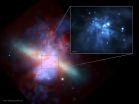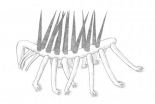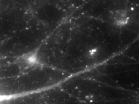(Press-News.org) The universe has so many black holes that it's impossible to count them all. There may be 100 million of these intriguing astral objects in our galaxy alone. Nearly all black holes fall into one of two classes: big, and colossal. Astronomers know that black holes ranging from about 10 times to 100 times the mass of our sun are the remnants of dying stars, and that supermassive black holes, more than a million times the mass of the sun, inhabit the centers of most galaxies.
But scattered across the universe like oases in a desert are a few apparent black holes of a more mysterious type. Ranging from a hundred times to a few hundred thousand times the sun's mass, these intermediate-mass black holes are so hard to measure that even their existence is sometimes disputed. Little is known about how they form. And some astronomers question whether they behave like other black holes.
Now a team of astronomers has accurately measured — and thus confirmed the existence of — a black hole about 400 times the mass of our sun in a galaxy 12 million light years from Earth. The finding, by University of Maryland astronomy graduate student Dheeraj Pasham and two colleagues, was published online August 17 in the journal Nature.
Co-author Richard Mushotzky, a UMD astronomy professor, says the black hole in question is a just-right-sized version of this class of astral objects.
"Objects in this range are the least expected of all black holes," says Mushotzky. "Astronomers have been asking, do these objects exist or do they not exist? What are their properties? Until now we have not had the data to answer these questions." While the intermediate-mass black hole that the team studied is not the first one measured, it is the first one so precisely measured, Mushotzky says, "establishing it as a compelling example of this class of black holes."
A black hole is a region in space containing a mass so dense that not even light can escape its gravity. Black holes are invisible, but astronomers can find them by tracking their gravitational pull on other objects. Matter being pulled into a black hole gathers around it like storm debris circling a tornado's center. As this cosmic stuff rubs together it produces friction and light, making black holes among the universe's brightest objects.
Since the 1970s astronomers have observed a few hundred objects that they thought were intermediate-mass black holes. But they couldn't measure their mass, so they couldn't be certain. "For reasons that are very hard to understand, these objects have resisted standard measurement techniques," says Mushotzky.
Pasham, who will receive his Ph.D. in astronomy at UMD August 22, focused on one object in Messier 82, a galaxy in the constellation Ursa Major. Messier 82 is our closest "starburst galaxy," where young stars are forming. Beginning in 1999 a NASA satellite telescope, the Chandra X-ray Observatory, detected X-rays in Messier 82 from a bright object prosaically dubbed M82 X-1. Astronomers, including Mushotzky and co-author Tod Strohmayer of NASA's Goddard Space Flight Center, suspected for about a decade that the object was an intermediate-mass black hole, but estimates of its mass were not definitive enough to confirm that.
Between 2004 and 2010 NASA's Rossi X-Ray Timing Explorer (RXTE) satellite telescope observed M82 X-1 about 800 times, recording individual x-ray particles emitted by the object. Pasham mapped the intensity and wavelength of x-rays in each sequence, then stitched the sequences together and analyzed the result.
Among the material circling the suspected black hole, he spotted two repeating flares of light. The flares showed a rhythmic pattern of light pulses, one occurring 5.1 times per second and the other 3.3 times per second – or a ratio of 3:2.
The two light oscillations were like two dust motes stuck in the grooves of a vinyl record spinning on a turntable, says Mushotzky. If the oscillations were musical beats, they would produce a specific syncopated rhythm. Think of a Latin-inflected bossa nova, or a tune from The Beatles' Abbey Road:
"Mean Mister Mustard sleeps in the park, shaves in the dark, try'na save paper."
In music, this is a 3:2 beat. Astronomers can use a 3:2 oscillation of light to measure a black hole's mass. The technique has been used on smaller black holes, but it has never before been applied to intermediate-mass black holes.
Pasham used the oscillations to estimate that M82 X-1 is 428 times the mass of the sun, give or take 105 solar masses. He does not propose an explanation for how this class of black holes formed. "We needed to confirm their existence observationally first," he says. "Now the theorists can get to work."
Though the Rossi telescope is no longer operational, NASA plans to launch a new X-ray telescope, the Neutron Star Interior Composition Explorer (NICER), in about two years. Pasham, who will begin a post-doctoral research position at NASA Goddard in late August, has identified six potential intermediate-mass black holes that NICER might explore.
This work is based on observations made with the Rossi X-ray Timing Explorer (RXTE), managed and controlled by NASA's Goddard Space Flight Center in Greenbelt, Md. The content of this article does not necessarily reflect the views of NASA or Goddard Space Flight Center.
INFORMATION:
Richard F. Mushotzky home page:
http://www.astro.umd.edu/people/richard.html
Dheeraj R. Pasham home page:
http://www.astro.umd.edu/~dheeraj/
"A 400 solar mass black hole in the M82 galaxy," Dheeraj R. Pasham, Tod E. Strohmayer, Richard F. Mushotzky, was published online Aug. 17, 2014 in Nature. Download a copy upon publication at http://dx.doi.org/10.1038/nature13710.
Media contact:
Heather Dewar, 301-405-9267, hdewar@umd.edu
University of Maryland
College of Computer, Mathematical, and Natural Sciences
2300 Symons Hall
College Park, Md. 20742
http://www.cmns.umd.edu
@UMDscience
About the College of Computer, Mathematical, and Natural Sciences
The College of Computer, Mathematical, and Natural Sciences at the University of Maryland educates more than 7,000 future scientific leaders in its undergraduate and graduate programs each year. The college's 10 departments and more than a dozen interdisciplinary research centers foster scientific discovery with annual sponsored research funding exceeding $150 million.
Fascinating rhythm: Light pulses illuminate a rare black hole
UMD, NASA astronomers track an intermediate-mass black hole from syncopated flares of light
2014-08-17
ELSE PRESS RELEASES FROM THIS DATE:
A shift in the code: New method reveals hidden genetic landscape
2014-08-17
Cold Spring Harbor, NY – With three billion letters in the human genome, it seems hard to believe that adding a DNA base here or removing a DNA base there could have much of an effect on our health. In fact, such insertions and deletions can dramatically alter biological function, leading to diseases from autism to cancer. Still, it is has been difficult to detect these mutations. Now, a team of scientists at Cold Spring Harbor Laboratory (CSHL) has devised a new way to analyze genome sequences that pinpoints so-called insertion and deletion mutations (known as "indels") ...
New home for an 'evolutionary misfit'
2014-08-17
One of the most bizarre-looking fossils ever found - a worm-like creature with legs, spikes and a head difficult to distinguish from its tail – has found its place in the evolutionary Tree of Life, definitively linking it with a group of modern animals for the first time.
The animal, known as Hallucigenia due to its otherworldly appearance, had been considered an 'evolutionary misfit' as it was not clear how it related to modern animal groups. Researchers from the University of Cambridge have discovered an important link with modern velvet worms, also known as onychophorans, ...
Stem cells reveal how illness-linked genetic variation affects neurons
2014-08-17
VIDEO:
Human neurons firing
Click here for more information.
A genetic variation linked to schizophrenia, bipolar disorder and severe depression wreaks havoc on connections among neurons in the developing brain, a team of researchers reports. The study, led by Guo-li Ming, M.D., Ph.D., and Hongjun Song, Ph.D., of the Johns Hopkins University School of Medicine and described online Aug. 17 in the journal Nature, used stem cells generated from people with and without mental illness ...
New Stanford research sheds light on how children's brains memorize facts
2014-08-17
As children learn basic arithmetic, they gradually switch from solving problems by counting on their fingers to pulling facts from memory. The shift comes more easily for some kids than for others, but no one knows why.
Now, new brain-imaging research gives the first evidence drawn from a longitudinal study to explain how the brain reorganizes itself as children learn math facts. A precisely orchestrated group of brain changes, many involving the memory center known as the hippocampus, are essential to the transformation, according to a study from the Stanford University ...
Suspect gene corrupts neural connections
2014-08-17
Researchers have long suspected that major mental disorders are genetically-rooted diseases of synapses – the connections between neurons. Now, investigators supported in part by the National Institutes of Health have demonstrated in patients' cells how a rare mutation in a suspect gene disrupts the turning on and off of dozens of other genes underlying these connections.
"Our results illustrate how genetic risk, abnormal brain development and synapse dysfunction can corrupt brain circuitry at the cellular level in complex psychiatric disorders," explained Hongjun Song, ...
Stuck in neutral: Brain defect traps schizophrenics in twilight zone
2014-08-17
People with schizophrenia struggle to turn goals into actions because brain structures governing desire and emotion are less active and fail to pass goal-directed messages to cortical regions affecting human decision-making, new research reveals.
Published in Biological Psychiatry, the finding by a University of Sydney research team is the first to illustrate the inability to initiate goal-directed behaviour common in people with schizophrenia.
The finding may explain why people with schizophrenia have difficulty achieving real-world goals such as making friends, completing ...
Virginity pledges for men can lead to sexual confusion -- even after the wedding day
2014-08-17
Bragging of sexual conquests, suggestive jokes and innuendo, and sexual one-upmanship can all be a part of demonstrating one's manhood, especially for young men eager to exert their masculinity.
But how does masculinity manifest itself among young men who have pledged sexual abstinence before marriage? How do they handle sexual temptation, and what sorts of challenges crop up once they're married?
"Sexual purity and pledging abstinence are most commonly thought of as feminine, something girls and young women promise before marriage," said Sarah Diefendorf, a sociology ...
Study finds range of skills students taught in school linked to race and class size
2014-08-17
SAN FRANCISCO -- Pressure to meet national education standards may be the reason states with significant populations of African-American students and those with larger class sizes often require children to learn fewer skills, finds a University of Kansas researcher.
"The skills students are expected to learn in schools are not necessarily universal," said Argun Saatcioglu, a KU associate professor of education and courtesy professor of sociology.
In effort to increase their test scores and, therefore, avoid the negative consequences of failing to meet the federal standards ...
Study suggests federal law to combat use of 'club drugs' has done more harm than good
2014-08-17
SAN FRANCISCO — A federal law enacted to combat the use of "club drugs" such as Ecstasy — and today's variation known as Molly — has failed to reduce the drugs' popularity and, instead, has further endangered users by hampering the use of measures to protect them.
University of Delaware sociology professor Tammy L. Anderson makes that case in a paper she will present at the 109th Annual Meeting of the American Sociological Association. The paper, which has been accepted for publication this fall in the American Sociological Association journal Contexts, examines the unintended ...
Risky situations increase women's anxiety, hurt their performance compared to men
2014-08-17
SAN FRANCISCO — Risky situations increase anxiety for women but not for men, leading women to perform worse under these circumstances, finds a study to be presented at the 109th Annual Meeting of the American Sociological Association.
"On the surface, risky situations may not appear to be particularly disadvantageous to women, but these findings suggest otherwise," said study author Susan R. Fisk, a doctoral candidate in sociology at Stanford University, who defines a risky situation as any setting with an uncertain outcome in which there can be both positive or negative ...
LAST 30 PRESS RELEASES:
Research alert: Spreading drug costs over the year may ease financial burden for Medicare cancer patients
Hospital partnership improves follow up scans, decreases long term risk after aortic repair
Layered hydrogen silicane for safe, lightweight, and energy-efficient hydrogen carrier
Observing positronium beam as a quantum matter wave for the first time
IEEE study investigates the effects of pointing error on quantum key distribution systems
Analyzing submerged fault structures to predict future earthquakes in Türkiye
Quantum ‘alchemy’ made feasible with excitons
‘Revoice’ device gives stroke patients their voice back
USF-led study: AI helps reveal global surge in floating algae
New method predicts asthma attacks up to five years in advance
Researchers publish first ever structural engineering manual for bamboo
National poll: Less than half of parents say swearing is never OK for kids
Decades of suffering: Long-term mental health outcomes of Kurdish chemical gas attacks
Interactional dynamics of self-assessment and advice in peer reflection on microteaching
When aging affects the young: Revealing the weight of caregiving on teenagers
Can Canada’s health systems handle increased demand during FIFA World Cup?
Autistic and non-autistic faces may “speak a different language” when expressing emotion
No clear evidence that cannabis-based medicines relieve chronic nerve pain
Pioneering second-order nonlinear vibrational nanoscopy for interfacial molecular systems beyond the diffraction limit
Bottleneck in hydrogen distribution jeopardises billions in clean energy
Lung cancer death rates among women in Europe are finally levelling off
Scientists trace microplastics in fertilizer from fields to the beach
The Lancet Obstetrics, Gynecology, & Women’s Health: Taking paracetamol during pregnancy does not increase risk of autism, ADHD or intellectual disabilities, confirms new gold-standard evidence review
Taking paracetamol during pregnancy does not increase risk of autism, ADHD or intellectual disabilities
Harm reduction vending machines in New York State expand access to overdose treatment and drug test strips, UB studies confirm
University of Phoenix releases white paper on Credit for Prior Learning as a catalyst for internal mobility and retention
Canada losing track of salmon health as climate and industrial threats mount
Molecular sieve-confined Pt-FeOx catalysts achieve highly efficient reversible hydrogen cycle of methylcyclohexane-toluene
Investment in farm productivity tools key to reducing greenhouse gas
New review highlights electrochemical pathways to recover uranium from wastewater and seawater
[Press-News.org] Fascinating rhythm: Light pulses illuminate a rare black holeUMD, NASA astronomers track an intermediate-mass black hole from syncopated flares of light




